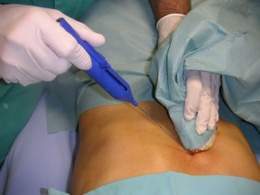It consists of obtaining a sample of liver tissue for later study under a microscope . The liver is punctured with a needle that aspirates or cuts a small piece of liver. It is important to note that performing a liver biopsy does not mean that the patient has cancer.

Alternative names
Liver biopsy; Percutaneous biopsy
Techniques
There are four ways to perform a liver biopsy:
- Blind percutaneous liver biopsy. It is the most common technique. After performing an abdominal ultrasound to identify the liver and rule out the existence of intrahepatic lesions that contraindicate this technique (vascular lesions, etc.), the puncture is performed at the level of the eighth or ninth right intercostal space of the mid-axillary line.
- Percutaneous liver biopsy under radiological control (ultrasound or CT). In this situation, the puncture is performed under continuous radiological control (mainly ultrasound) that guides the needle at the moment of puncture. This technique allows directing the biopsy and has its main indication when trying to puncture an intrahepatic lesion, when the size of the liver is smaller than usual or when there are intrahepatic areas that should not be punctured (hemangiomas, intrahepatic gallbladder, intestinal interposition, etc.) .
- Laparoscopic liver biopsy. Laparoscopy allows, unlike previous techniques, to directly visualize the liver and perform direct hemostatic control in the event of bleeding.
- Transjugular liver biopsy. The liver can be accessed through the jugular vein. After introducing a catheter through this venous access, the right hepatic vein is reached, which can be punctured to obtain a liver tissue sample. Although the cost-effectiveness of this technique is lower, it is considered appropriate when coagulation is impaired and, therefore, there is a high risk of bleeding.
Reasons
The indications for liver biopsy are varied. However, the most frequent are usually:
- Know the degree of injury of a known chronic liver disease. For example, determining the degree of inflammation in a patient with viral hepatitis or alcoholic hepatitis.
- Try to establish the diagnosis in a patient with chronic biochemical alteration of liver tests and whose diagnosis has not been achieved by other analytical, radiological and / or endoscopic studies.
- Know the nature of an intrahepatic lesion, not defined with other studies.
Other reasons, although less frequent, are: study of a patient with fever of unknown origin; assessment of the degree of drug- induced liver injury ; quantify liver iron and / or copper concentration ; and rule out an infiltrative process in the study of hepatomegaly.
Preparation
Before performing a liver biopsy, the patient will undergo an analytical control that should include a blood count and a coagulation study to reduce the risk of bleeding . The day of the test the patient must remain fasting. Likewise, if you are being treated with antiaggregants, anticoagulants or anti-inflammatories, you must suspend them a few days before performing the biopsy. You should also have an ultrasound , especially if you are considering performing a blind puncture. The objective is to rule out injuries that contraindicate this technique and mark the most appropriate point for performing the puncture. It will also indicate the depth and the direction that the needle should follow.
Realization
Usually, liver biopsy is performed under a 24-hour admission regimen. After percutaneous biopsy, with or without radiological control, the skin is cleaned with an antiseptic iodine solution and a local anesthetic is administered. When the anesthetic effect has been achieved, and to avoid injury to the liver, the patient must hold their breath while the puncture is performed.
Care
After carrying out the liver biopsy, the patient must lie down, rest and lean on the biopsy area to make local compression during the first 4 or 6 hours, which are the ones with the highest risk of bleeding. During these hours your blood pressure and heart rate should be checked regularly . After these first hours, the patient must remain in bed for up to 24 hours. Then he can be discharged and lead a normal life.
Risks
Liver biopsy, despite being a good technique to perform, carries the risk of complications. These range from pain at the biopsy site to more serious complications such as bleeding or perforation of a hollow viscus . Minor complications include pain and vasovagal syncope. They are the most frequent and easily controllable. Major complications are less common and include:
- Hemorrhage. It is the most common serious complication, ranging between 1.7% and 0.062%.
- Puncture of other organs . It is the second complication in order of frequency. Puncture of the lung , manifested by a pneumothorax, occurs with a frequency between 0.55% and 0.35%. Puncture of other organs such as the kidney , colon and, exceptionally, the pancreas , adrenal glands and small intestine has also been described . Most of the punctures of these organs are completely asymptomatic.
- Biliary peritonitis Its frequency is 0.22% and it is due to the puncture of an intrahepatic bile duct, the extrahepatic bile duct or the gallbladder .
- Arteriovenous fistulas. They occur when the puncture reaches branches of the hepatic and venous arteries. They are usually asymptomatic and tend to close over time.
- Infection. Secondary bacteremia is relatively common, especially in patients with cholangitis. The appearance of sepsis is less common.
- Tumor spread. Very rare, and always secondary to the puncture of tumor processes.
